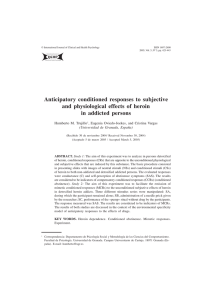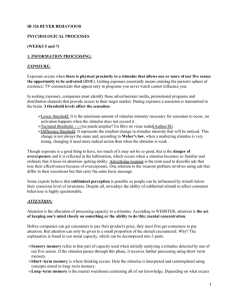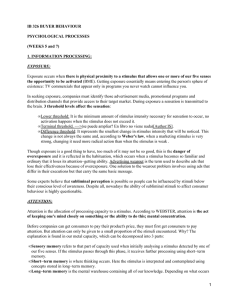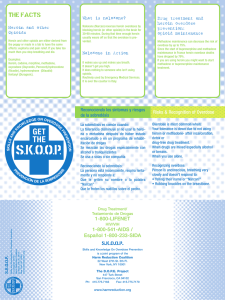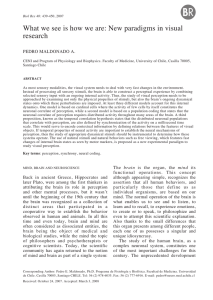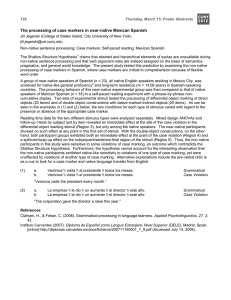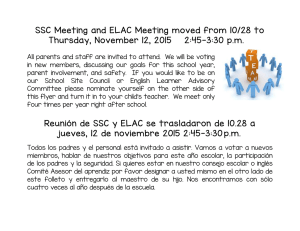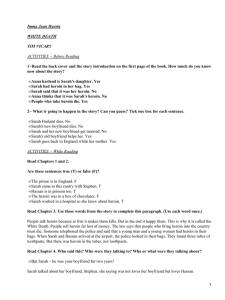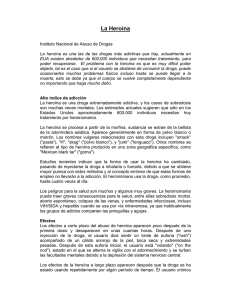View PDF - Psicothema
Anuncio
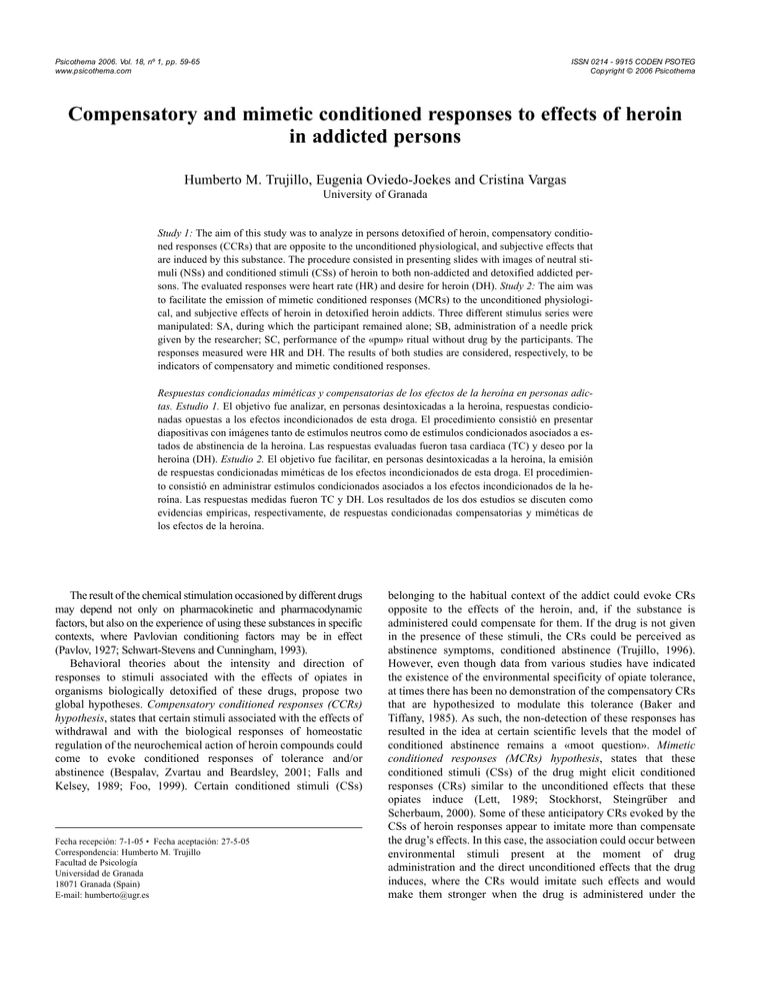
Psicothema 2006. Vol. 18, nº 1, pp. 59-65 www.psicothema.com ISSN 0214 - 9915 CODEN PSOTEG Copyright © 2006 Psicothema Compensatory and mimetic conditioned responses to effects of heroin in addicted persons Humberto M. Trujillo, Eugenia Oviedo-Joekes and Cristina Vargas University of Granada Study 1: The aim of this study was to analyze in persons detoxified of heroin, compensatory conditioned responses (CCRs) that are opposite to the unconditioned physiological, and subjective effects that are induced by this substance. The procedure consisted in presenting slides with images of neutral stimuli (NSs) and conditioned stimuli (CSs) of heroin to both non-addicted and detoxified addicted persons. The evaluated responses were heart rate (HR) and desire for heroin (DH). Study 2: The aim was to facilitate the emission of mimetic conditioned responses (MCRs) to the unconditioned physiological, and subjective effects of heroin in detoxified heroin addicts. Three different stimulus series were manipulated: SA, during which the participant remained alone; SB, administration of a needle prick given by the researcher; SC, performance of the «pump» ritual without drug by the participants. The responses measured were HR and DH. The results of both studies are considered, respectively, to be indicators of compensatory and mimetic conditioned responses. Respuestas condicionadas miméticas y compensatorias de los efectos de la heroína en personas adictas. Estudio 1. El objetivo fue analizar, en personas desintoxicadas a la heroína, respuestas condicionadas opuestas a los efectos incondicionados de esta droga. El procedimiento consistió en presentar diapositivas con imágenes tanto de estímulos neutros como de estímulos condicionados asociados a estados de abstinencia de la heroína. Las respuestas evaluadas fueron tasa cardíaca (TC) y deseo por la heroína (DH). Estudio 2. El objetivo fue facilitar, en personas desintoxicadas a la heroína, la emisión de respuestas condicionadas miméticas de los efectos incondicionados de esta droga. El procedimiento consistió en administrar estímulos condicionados asociados a los efectos incondicionados de la heroína. Las respuestas medidas fueron TC y DH. Los resultados de los dos estudios se discuten como evidencias empíricas, respectivamente, de respuestas condicionadas compensatorias y miméticas de los efectos de la heroína. The result of the chemical stimulation occasioned by different drugs may depend not only on pharmacokinetic and pharmacodynamic factors, but also on the experience of using these substances in specific contexts, where Pavlovian conditioning factors may be in effect (Pavlov, 1927; Schwart-Stevens and Cunningham, 1993). Behavioral theories about the intensity and direction of responses to stimuli associated with the effects of opiates in organisms biologically detoxified of these drugs, propose two global hypotheses. Compensatory conditioned responses (CCRs) hypothesis, states that certain stimuli associated with the effects of withdrawal and with the biological responses of homeostatic regulation of the neurochemical action of heroin compounds could come to evoke conditioned responses of tolerance and/or abstinence (Bespalav, Zvartau and Beardsley, 2001; Falls and Kelsey, 1989; Foo, 1999). Certain conditioned stimuli (CSs) Fecha recepción: 7-1-05 • Fecha aceptación: 27-5-05 Correspondencia: Humberto M. Trujillo Facultad de Psicología Universidad de Granada 18071 Granada (Spain) E-mail: humberto@ugr.es belonging to the habitual context of the addict could evoke CRs opposite to the effects of the heroin, and, if the substance is administered could compensate for them. If the drug is not given in the presence of these stimuli, the CRs could be perceived as abstinence symptoms, conditioned abstinence (Trujillo, 1996). However, even though data from various studies have indicated the existence of the environmental specificity of opiate tolerance, at times there has been no demonstration of the compensatory CRs that are hypothesized to modulate this tolerance (Baker and Tiffany, 1985). As such, the non-detection of these responses has resulted in the idea at certain scientific levels that the model of conditioned abstinence remains a «moot question». Mimetic conditioned responses (MCRs) hypothesis, states that these conditioned stimuli (CSs) of the drug might elicit conditioned responses (CRs) similar to the unconditioned effects that these opiates induce (Lett, 1989; Stockhorst, Steingrüber and Scherbaum, 2000). Some of these anticipatory CRs evoked by the CSs of heroin responses appear to imitate more than compensate the drug’s effects. In this case, the association could occur between environmental stimuli present at the moment of drug administration and the direct unconditioned effects that the drug induces, where the CRs would imitate such effects and would make them stronger when the drug is administered under the 60 HUMBERTO M. TRUJILLO, EUGENIA OVIEDO-JOEKES AND CRISTINA VARGAS control of the specific conditioned environment (conditioned sensitivity). The conditions that favor the appearance of each of these two forms of response are still not clear. There are few studies done with humans that contribute data sufficiently consistent with the proposed model. In summary, it would seem that the mediating variables in these phenomena and the mechanisms by which they are organized are, at least in part, unknown. STUDY 1 The aim of this study was to analyze, in persons organically detoxified of heroin, the magnitude and topography of heart rate responses and desire for heroin in the presence of contextual stimuli of heroin (CS), associated in the past with physiological and subjective states of abstinence. Method Participants Two groups of persons participated in this study. The first group, termed the control group (CG), included 12 men and 12 women who had never had any direct experience with opiate drugs, but had sporadic contact with tobacco and alcohol. Their ages ranged from 25 to 32 years, with a mean (ME) of 29.30 years, and standard deviation (SD) of 2.11.The second group, the experimental group (EG), was also composed of 12 men and 12 women, with the same age range as the CG, a ME of 28.80 years, and a SD of 2.30. All the EG participants had used tobacco, alcohol, cannabis, and psychoactive substances. Besides, they had direct experience with heroin (diacetylmorphine) through intravenous administration during a minimum of 58 months, and had reached a high level of addiction. The EG persons had been detoxified without pharmacological treatment, for three months, from all the above-mentioned substances. They had sporadic contact with tobacco and alcohol. During the running of the study, they were in out-patient treatment programs in the drug dishabituation phase, in de Provincial Center for Drugdependency of Granada. All the persons of CG and EG were a voluntaries participants. was the following: SSA, (1) 5 minutes of adaptation to the experimental chamber during which 5 flashes of white light in intervals of one minute were presented; (2) presentation of the 4 NSs, each with a duration of 3 minutes, and a 3 minute darkened interval between each; and, (3) 40 seconds of darkness. SSB, the sequential order of this condition was the same as that used in SSA, the only difference being the substitution by CS4 for NS4. SSC, the sequential order of this condition was the same as that used in SSA, the only difference being that all 4 NSs were substituted by the 4 CSs. Dependent variables Heart Rate (HR), this was used as a representative index of cardiovascular activity, and was chosen in that it is one of the most commonly used autonomic measures in psychophysiology, specifically in the area of research of the present study. A photoelectric transducer was used that incorporated a photoconductor cell to detect changes produced, with each heartbeat, in the optical density of the finger tissue. Beginning with the biological-physical signal of the pulse, through a cardiotacometer (an amplifier and signal converter), the intervals between beats were transformed into HR (beats per minute) expressed in real time, beat by beat. Phasic activity was measured by analyzing cardiac changes (HR in beats per minute), second by second, posterior to the presentation of the different stimuli that constituted the stimulus series A, B, and C, described above. That is, the measure of change in cardiac activity was obtained by subtracting from the mean value of HR in the 20 seconds after each stimulus of the different series, the mean value of HR in the 10 seconds before the first stimulus presentation of each series (baseline). Desire for Heroin (DH), this was used as an index of the «need» for the drug. Participants self-evaluated the desire that they had for the drug using a rating scale that ranged from 0 to 100 points, where zero signified «total absence of desire», and 100 «greatest desire». This evaluation was carried out with an answer sheet, produced for this purpose, before and after the presentation of the stimulus series described above (series A, B, and C). To facilitate the statistical analysis, the points obtained from the ratings scale with range 0-100 were transformed to a range of 0-10. Apparatus Stimulus material Eight different slides were used; four made of neutral stimuli (NSs) and four of conditioned stimuli (CSs). The NSs, termed NS1, NS2, NS3, and NS4, were composed of achromatic images of unfamiliar shapes. The CSs, termed CS1, CS2, CS3, and CS4, showed compound stimuli composed of images of acts and utensils related to the habitual preinjection setting of heroin, and as such, frequently associated with states of abstinence. The EG participants were asked, a week before, to order the four CS slides from least to most in their power to evoke desire for the drug. Ordering of stimuli by all 24 EG participants were: CS1, CS2, CS3, and CS4. This arrangement likewise coincided with that predicted by the researchers, taking into account the number of stimulus elements that constituted each slide as a compound stimulus. The sequential order of presentation of experimental conditions that constituted the stimulus series A, B, and C (SSA, SSB, SSC), each one presented in three consecutive daily sessions, The different stimulus images (NSs, CSs, and flashes of white light) were presented using a projector. The stimuli were projected onto a screen, 150 cm × 100 cm, located in front of the participant at a distance of 3 meters. The recording of the physiological variable was carried out through use of a Letica polygraph, model Leti-Graph 2000, with two recording channels on paper and a thermal pen. Here, one amplifier was fit, to record cardiac activity (Letica amplifier cardiotachometer CAR 300). Collecting the biologic- physical pulse signal was accomplished with a Letica photoelectric transducer, model TRU 300, located at the first joint of the middle finger of the right hand. During recording of the cardiac, speed of paper advance was 2mm/sec. Computer controlled the presentation and duration of the stimuli, as well as the recording of the response. As such, an input-output DIG 720 card, from Med Associates, INC controlled the polygraph event marker and the slide projector, through an electronic interconnection relay built for this purpose. The card was in a computer loaded with all the COMPENSATORY AND MIMETIC CONDITIONED RESPONSES TO EFFECTS OF HEROIN IN ADDICTED PERSONS necessary control programs. These were written in Turbo Basic (computer language). During the entire session, the subjects wore Ross headphones, model RE-223, through which they listened to a background noise of a 20-decibel intensity produced by the CPU (central processing unit) of the computer. Procedure Before each session, the participants detoxified of heroin underwent a drug analysis test for the detection of opiates in the urine. ONTRAK, from Roche Diagnostic Systems, was the detection Kit used for this purpose. If de result was negative, the session continued. To control for environmental artifacts, the physical conditions of the experimental chamber were held constant throughout the sessions and for all participants. Thus, the study was carried out in a sound proof, odorless chamber, with the temperature ranging from 20 to 25 degrees centigrade (68 to 77 degrees Fahrenheit), and illuminated with a pale light of 10 watts. The variable electric fields of the room were controlled by grounding the participants. Design The research design was an independent groups with repeated measures across all participants (in each group), such that all persons in the study experienced all the stimuli that constituted the stimulus series (SSA, SSB, SSC). Thus, for all participants in both the CG and the EG, the HR response was measured in the presence of each of the four stimuli that formed the stimulus series A, B, and C, thus obtaining four values for physiological variable for each participantt and series. Also, the DH response was measured before and after the stimulus series A, B, and C. The order of presentation of the three stimulus series (SSA, SSB, SSC) was assigned in an incomplete counterbalance format, resulting in six sequences, each one of these composed of the same previous stimulus series, but ordered differently. The 48 participants in the study (24 from the CG, 24 from the EG) were divided into 12 distinct groups, each one with two men and two women. To specify, each one of the 12 groups passed through a sequence of stimulus series that another group had already experienced, given that there were only six sequences used (from the incomplete counterbalance). Additionally, it is to be noted that of the two men and two women in each (of the 12) groups, one man and one woman were from the CG, and one each from the EG. The physiological variable, HR in the presence of both the neutral and conditioned stimuli, was studied by means of a mixed factorial design. Here, the factor termed Group was divided into two levels: one level called «control group» (CG), the second one called «experimental group» (EG). The factor Sex was also made of two independent groups, and divided into two levels: «men» and «women». The factor Stimulus Series was the repeated measures factor, and was manipulated within subjects at three levels: a first level termed «SSA», a second level «SSB», and a third level termed «SSC». Finally, the factor termed Stimulus was, as the previous one, of repeated measures, and used within subjects manipulations at four levels: «S1», «S2», «S3», «S4». To be precise, the neutral and the conditioned characteristics of the stimuli that made up each of the levels of the factor Stimulus changed according to the stimulus series in which these stimuli were found. The subjective variable desire for heroin (DH) was studied through a mixed factorial design. The factors Group and 61 Sex were independent groups, each manipulated at two levels: «CG» and «EG», and «men» and «women», respectively. The factor Stimulus Series was a repeated measure, with withinsubject manipulations at three levels: «SSA», «SSB», and «ASSC». Finally, the factor Moment of Evaluation was likewise a repeated measures factor, with intrasubject manipulations at two levels: a first level termed «before the stimulus series» (PRE), and the second level termed «after the stimulus series» (POST). Statistical analysis First, using a 2×2(×4×3) ANOVA, the values for HR from both the CG and EG were analyzed, taking into account the two levels of the Sex factor, in the presence of each of the four stimuli that composed the stimulus series A, B, and C. Next, using a 2×2(×3×2) ANOVA, the values of DH from both, the CG and EG were analyzed, taking into account the two levels of the Sex factor, before and after the presentations of the stimulus series A, B, and C. With the factors that were manipulated between groups, a p<0.05 was used when determining level of significance. A p<0.01 was used when analyzing the within-subject factors. To adjust the degrees of freedom in the repeated measures factors, the Greenhouse-Geisser Epsilon correction (GG) was applied. However, the results are reported with the original degrees of freedom and the corrected probability values. Results After conducting the statistical analysis of the data, it was seen that there was no effect of the factor Sex; neither was there a significant interaction effect of this factor with the others. Because of this, and to simplify the figures of the resulting data, the Sex factor was omitted. Heart Rate The results of a 2×2(×3×4) ANOVA showed statistically significant main effects of the Group factor (F(1,44)= 132.08, p<0.01), the Series Stimulus factor (F(2,88)= 201.92, p<0.01; GG<0.001), and the Stimulus factor (F(3,132)= 62.39, p<0.01; GG<0.003). There was a statistically significant interaction effect of the three above-mentioned factors (F(6,264)= 14.20, p<0.01; GG<0.005). The results do not show significant effects of the stimuli in the stimulus series for the CG. The same is true for the stimuli of stimulus series A for the EG. Significant effects were seen with the stimuli in SSB in the EG (F(3,69)= 48.20, p<0.01; GG<0.001). That is, statistically significant differences were found in comparing NS1 with CS4 (F(1,23)= 85.15, p<0.01), NS2 with CS4 (F(1,23)= 102.53, p<0.01), and NS3 with CS4 (F(1,23)= 60.91, p<0.01). With the EG participants the rest of the comparisons did not yield significant differences. A significant effect was found in the stimuli of SSC in the EG (F(3,69)= 71.68, p<0.01; GG<0.004). Significant differences were seen in comparing CS1 with CS2 (F(1,23)= 15.91, p<0.01), CS2 with CS3 (F(1,23)= 74.51, p<0.01) and CS3 with CS4 (F(1,23)= 40.44, p<0.01). Significant differences were found in comparing the CG with the EG after the presentation of CS4 in SSB (F(1,47)= 52.12, p<0.01) and after presenting, in SSC, CS1 (F(1,47)= 115.03, p<0.01), CS2 (F(1,47)= 92.66, p<0.01), CS3 (F(1,47)= 166.31, p<0.01), and CS4 (F(1,47)= 159.26, p<0.01). No significant 62 HUMBERTO M. TRUJILLO, EUGENIA OVIEDO-JOEKES AND CRISTINA VARGAS The results of a 2×2(×3×2) ANOVA showed significant effects of the Group factor (F(1,44)= 244.32, p<0.01), Stimulus Series factor (F(2,88)= 78.15, p<0.01; GG<0.002), and Moment of Evaluation factor (F(1,44)= 214.27, p<0.01). There was a significant Group x Stimulus Series x Moment of Evaluation interaction effect (F(2,88)= 109.91, p<0.01; GG<0.001). Significant differences were found in the EG subjects, comparing the values of DH obtained before the SSA with those obtained after (F(1,23)= 23.45, p<0.01). The same occurred in the SSB (F(1,23)= 91.80, p<0.01) and the SSC (F(1,23)= 182.76, p<0.01). This was not the case in the CG subjects across the above-listed stimulus series. Significant differences were seen between CG participants and EG participants, after SSB (F(1,46)= 90.45, p<0.01), and after SSC (F(1,46)= 207.56, p<0.01). No significant differences were found in the DH values, in CG or in EG subjects, before the stimulus series A, B, and C, nor in the values obtained for CG subjects after these series. Significant differences were found in the EG after these above-listed series (F(2,46)= 93.19, p<0.01; GG<0.003). In EG participants significant differences were seen in comparing the DH values obtained after SSA with those obtained after SSB (F(1,23)= 44.61, p<0.01) and those obtained after SSC (F(1,23)= 121.29, p<0.01) (see Figure 2). Discussion According to these data, it may be that the CSs, while evoking certain CRs of physiological disequilibriun (CCRs to the effects of heroin) were favoring the development of interoceptive stimuli and that were interpreted as sings and symptoms of abstinence capable in themselves of eliciting desire responses for the drug. Some of the results obtained in the present study corroborate those obtained previously by different authors at different times. Various authors detected subjective responses of desire for heroin in the presence of certain predrug CSs (Childress et al., 1993). Others detected increases in heart rate values (Sideroff and Jarvik, 1980). STUDY 2 This study was done six weeks after the study 1. The aim was to detect, in the presence of certain CSs related to heroin, CRs mimetic to the direct physiological and subjective effects produced by this drug in an unconditioned form Change in Heart Rate Desire for heroin Some of the novel results obtained in this study that could supply new evidence in favor of the environmental specificity of abstinence model in humans were: (1) the detection of a stronger evocative power of compensatory CRs by sequences composed of various CSs compounds than by a single CS compound; and, (2) the detection of a lack of necessity, on the part of the addict, of expectations of drug availability for the CRs of abstinence to arise. 10 9 8 7 6 5 4 3 2 1 0 NS1 NS2 NS3 NS4 NS1 NS2 NS3 CS4 CS1 CS2 CS3 CS4 SSA SSB CG SSC EG Figure 1. Effects of the stimuli that comprised the stimulus series A, B and C (SSA, SSB, SSC), on the magnitude of change in heart rate responses (beats per minute), in the Control and the Experimental Groups (CG, EG) Desire for Heroin differences were found between the CG and the EG after presenting NS1, NS2, NS3, or NS4 in SSA; neither after presenting the NS1, NS2, or NS3 in SSB. Of particular interest is the result showing that the EG participants responded with larger increments in HR in the presence of the CS with more stimulus elements (CS4), when this was preceded by other CSs, than when preceded by NSs. Thus in the EG participants, significant differences were found between the CS4 in SSB and the CS4 in SSC (F(1,23)= 77.60, p<0.01). This was not so in the CG participants (see Table 1 and Figure 1). 9 8 7 6 5 4 3 2 1 0 M=7,70 SD=1,86 M=0 M=0 SD=0 SD=0 M=0 M=0,16 SD=0 SD=0,43 SSA SSB M=2,80 SD=1,25 M=0,59 M=0,26 M=0 SD=0,32 SD=1,14 SD=0 SSC M=0,95 SD=0,93 SSA SSB CG M=8,46 SD=2,43 M=1,68 SD=1,23 SSC EG PRE POST Figure 2. Subjective response of desire for heroin (0-10), before (PRE) and after (POST) presentation of stimulus series A, B and C (SSA, SSB, SSC), in the Control and the Experimental Groups (CG, EG) Table 1 Means (M) and Standards Desviations (SD) of the magnitude of change in heart rate responses (beats per minute), in the Control and the Experimental Groups (CG, EG) to effects of stimuli that comprised the stimulus series A, B and C (SSA, SSB, SSC) SSA SSB SSC NS1 NS2 NS3 NS4 NS1 NS2 NS3 CS4 CS1 CS2 CS3 CS4 CG M SD 0,47 0,50 0,85 0,71 0,66 0,28 0,90 0,67 0,69 0,30 0,75 0,42 0,84 0,58 1,84 0,95 1,25 0,63 0,97 0,72 1,30 0,58 1,75 0,92 EG M SD 1,30 0,78 1,83 0,76 1,87 0,85 1,96 0,88 1,34 0,58 1,26 0,61 1,91 0,67 7,63 1,70 4,81 1,42 5,99 1,29 7,85 1,76 9,59 1,80 COMPENSATORY AND MIMETIC CONDITIONED RESPONSES TO EFFECTS OF HEROIN IN ADDICTED PERSONS Method Participants The participants of this study were the same as EG in study 1. Stimulus materials Two different stimuli were used: (1) a slight needle prick administered by the researcher in the area about where the participant used to inject himself in the past, using a disposable hypodermic needle very different from the type used during the heroin use; (2) a stimulus complex composed of visual and tactile elements pertaining to the behavioral chain of drug selfadministration. That is, the participant performed the ritual of «pump» without the drug for 30 seconds, using a hypodermic needle and an insulin-type syringe like those commonly used for heroin administration, in the same point of the arm where the drug had been injected in the past. Both the needle and the syringe were disposable. These stimuli were temporally organized within the stimulus series A, B, and C (SA, SB, SC). The stimulus order that formed each series was as follows: SA, (1) 5 minutes of adaptation to the experimental room where the variables were recorded during which the participant remained alone, (2) 3 minutes of control condition, during which the participant remained alone; SB, (1) 5 minutes of adaptation to the experimental room where the variables were recorded during which the participant remained alone, (2) 3 minutes during which the participant remained alone, and the researcher administered the needle prick 30 seconds before the end of this period; SC, (1) 5 minutes of adaptation to the experimental room where the variables were recorded during which the participant remained alone, (2) 3 minutes during which the participant remained alone, and then the participantt performed the «pump» ritual during the last 30 seconds of this period. Design The design used two independent groups (12 men, 12 women) with multiple replications across participants so that each was exposed to the stimuli complexes in the three stimulus series A, B, and C. Thus, for all participants, the response HR in each series was measured; that is, one value for the responses for each subject in each series was obtained. In addition, DH, was measured before and after each stimulus series. The order of presentation of the stimulus series was balanced, resulting in six different sequences each consisting of the three stimulus series but in different orders. Each of these six sequences was presented to six different groups of four persons each, so that each series of the three that formed each sequence was presented to the participants in a different day. Each of the six different groups of four persons was formed by randomly distributing the 24 participants of the study. Statistical analysis First, the values of HR in each stimulus series for the two groups, men and women, were assessed using an ANOVA 2(×3) (Sex × Stimulus Series). Then, the value of DH obtained for the groups= men and women before and after the three stimulus series were analyzed using an ANOVA 2(×3×2). The level of significance in the factors manipulated between groups was set at 0.05. The level of significance for the factors manipulated within subjects as well as for the interaction between groups and within subject factors was 0.01. To adjust the degrees of freedom in the repeated measure factors the Greenhouse-Geiser epsilon correction was applied. However, the results are presented with the original degrees of freedom and the corrected values of probability. After conducting the statistical analysis of the data, it was seen that there was no effect of the factor Sex. Because of this, and to simplify the figures of the resulting data, the Sex factor was omitted. Results Dependent variables Heart Rate (HR), this response was measured the same as the study 1. The phasic activity was measured analyzing the cardiac changes, second by second, after the administration of the stimulus series A, B, and C. The index of change in cardiac activity was obtained the same as study 1. Desire for Heroin (DH), this response was measured the same as the study 1. An answer sheet was provided to each participant to be completed before and after the stimulus series. To facilitate the statistical analysis the scores marked in the 0100 range were transformed to scores with a range of 0-10. Apparatus Recording of the physiological variable was done the same as the study 1. Procedure Each subject individually went through three sessions in three successive days, that is one session per day. The first moments were used to create a relaxed environment between the participant and the researcher. Next, urine analysis using the Ontrak «Kit», as in study 1, was performed for the detection of opiates. The physical conditions of the experimental room were as described in study 1. 63 Heart Rate The results of the ANOVA 2(×3) showed statistically significant effects of the factor Stimulus Series (F(2,44)= 18.54; p<0.01) (GG<0.003), not for the factor Sex or the interaction of the two factors. The analysis of the Stimulus Series showed that during the «pump» ritual without drug (SC), the change in HR was significantly smaller than control condition (SA) (F(1,24)= 26.08; p<0.01) and after the needle prick given by the researcher (SB) (F(1,24)= 25.40; p<0.01), with significant differences between the last two stimulus conditions (SA with SB) (F(1,24)= 15.62; p<0.01) (see Figure 3). Desire for Heroin The results of the ANOVA 2(×3×2) showed statistically significant effects of the factors Stimulus Series (F(2,44)= 21.03; p<0.01) (GG<0.007) and Moment of Evaluation (F(1,22)= 71.23; p<0.01), as well as for the interaction of these two (F(2,44)= 21.51; p<0.01). There were no significant effects of Sex or the interaction of this factor with the former two. The analysis of the interaction Stimulus Series x Moment of Evaluation showed values significantly greater after the needle prick by the researcher 64 HUMBERTO M. TRUJILLO, EUGENIA OVIEDO-JOEKES AND CRISTINA VARGAS (SB) than after control condition (SA) (F(1,23)= 38.71); p<0.01) and greater than the values obtained after the «pump» ritual (SC)(F(1,23)= 14.51; p<0.01). The results showed statistically significant differences between response values after control condition (SA) compared to those with given after the «pump» ritual without the drug (SC) (F(1,23)= 16.60; p<0.01). There were significantly greater values of DH after stimulus series B (F(1,23)= 66.91; p<0.01) and series C (F(1,23)= 17.14; p<0.01) than those seen before these stimulus series. No significant differences were seen between the values obtained before and after the stimulus series A (see Figure 4). one considers that the person sequentially received one nociceptive stimulus (needle prick). This could have occasioned a level of activation sufficiently high for him/her to self-perceive a relative state of organic disequilibrium that, in its turn, could have unleashed certain responses of heroin desire under control of a mechanism of negative reinforcement. What was novel in the empirical results of this study was the fact of having succeeded in evoking in detoxified heroin addicts CRs mimetic to the unconditioned effects of the drug. Discussion In the face of this dilemma of the non-detection of CCRs, think that it is not possible to evaluate these responses in certain systems of response because, in the absence of the effect of the drug, they are attenuated by mechanisms of homeostatic regulation, that is, by the lack of pharmacological preparation of the system that occasions the compensatory-type anticipatory RC. From this standpoint, it is possible to think that the detection or nondetection of these responses might not depend so much on the presence of the drug’s effect (pharmacological preparation of the system of response) as on the method used to evaluate these responses. However, what might actually be the case is that the non-detection of CCRs to the effects of the drug is due to the lack of stimulus generalization from the context where the responses were acquired to the context where they are being evaluated. For this reason, when designing studies for the detection of this kind of response class, it is necessary to be exceptionally meticulous in selection of the materials to be used and their manipulation. It must be made explicit that one should not negate the future possibilities of the ideas defended from the viewpoint of the comparative theory of habituation, characterized as such by Mackintosh (1987). Neither should one discard the utility of the model of tolerance as habituation, since it is necessary to consider, as do other researchers (Baker and Tiffany, 1985), that this model could be of great relevancy for understanding tolerance to drugs, if from within its framework one can make valuable predictions regarding the environmental specificity and extensions thereby. From this work’s perspective, that model does not take into account the CRs of abstinence as something underlying tolerance despite the high correlation that exists between both phenomena. It might be that these CSs, while evoking certain CRs of physiological disequilibrium (CRs compensatory to the effects of heroin), were favoring the development of interoceptive stimuli and that, being perceived by the addict, were interpreted as signs and symptoms of abstinence capable of bringing about responses of desire for heroin. However, this would be a very simplistic model that states that a detoxified addict would desire heroin and relapse into its use just because of this supposed negative reinforcement mechanism, when it is known that in every addictive behavioral process mechanisms of positive reinforcement maintained by the gratification of the drug also control the behavior. Additionally, other relevant factors are involved such as, for example, response cost of change to behavioral alternatives (Delgado and Pérez, 2004; Nureya, 1985), factors of learning about autoperception of interoceptive stimulation (García-Moreno et al., 2004), etc. Perhaps the efficacy of the programs for the treatment of heroin addiction could be bettered, at least in part, if one considered for the structure of the program that these given phenomena could easily be under specific contextual control. Change in Heart Rate If the control condition (SA) by itself, causes increments in HR and, however, after the CSs relevant to the «pump» ritual (SC) smaller values of this variable was obtained, then perhaps what occurred is that these ritual stimuli, while evoking MCRs to the physiological effects that heroin produces, counteracted the effects of cardiac activation because of their temporal proximity with the unconditioned effects of the drug after its administration. Regarding the subjective response of DH, it was seen that the participants demonstrated significantly greater values after the needle prick (SB) than those seen after control condition (SA) and after the «pump» ritual (SC). Perhaps, this might be expected if 9 8 7 6 5 4 3 2 1 0 M=8,40 SD=1,58 M=5,33 SD=0,91 M=3,10 SD=1,22 SA SB SC Figure 3. Effect of control condition (SA), effect of a needle prick (SB), and effect of «pump» ritual without the drug (SC) on the change of response of heart rate (beats per minute) in detoxified addicted participants M=6,29 SD=1,10 7 Desire for Heroin 6 5 M=4,03 SD=1,03 4 3 2 M=1,65 M=1,34 SD=0,60 SD=0,80 M=1,66 SD=0,72 M=1,58 SD=0,59 1 0 SA SB PRE SC POST Figure 4. Response of desire for heroin (0-10) before (PRE) and after (POST) of control condition (SA), before and after the needle prick (SB) and before and after the «pump» ritual without the drug (SC) in detoxified addicted participants General discussion COMPENSATORY AND MIMETIC CONDITIONED RESPONSES TO EFFECTS OF HEROIN IN ADDICTED PERSONS Regarding future research endeavors, it will be important to conduct studies for the identification of the functional relations 65 between anticipatory CRs (mimetic and compensatory) and drug relapse. References Baker, T.B. and Tiffany, S.T. (1985). Morphine tolerance as habituation, Psychological Review, 92, 78-108. Bespalav, A.Y., Zvartau, E.E. and Beardsley, P.M. (2001). Opioid NMDA receptor interactions may clarify conditioned (associative) components of opioid analgesic tolerance, Neuroscience and Biobehavioral Reviews, 25, 343-353. Childress, A.R., Hole, A.V., Ehrman, R.N., Robbins, S.J., McLelland, A.T. and O’Brien, C.P. (1993). Reactividad ante estímulos en la dependencia de la cocaína y los opiáceos: visión general de las estrategias para afrontar los deseos irresistibles de droga y la excitación condicionada. En Casas, M.C. y Gossop, M. (eds.): Tratamientos psicológicos en drogodependencias. Recaída y prevención de recaída (pp. 191-221). Sitges, España: Ediciones en Neurociencias. Delgado, D. and Pérez, A. (2004). La coodependencia en familiares de consumidores y no consumidores de sustancias psicoactivas. Psicothema, 16, 632-638. Falls, W.A. and Kelsey, J.E. (1989). Procedures that produce context-specific tolerance to morphine in rats also produce context-specific withdrawal, Behavioral Neuroscience, 103, 842-849. Foo, H. (1999). Acquisition and expression of conditioned hipoalgesia in morphine-naive and morphine-tolerant rats, Pharmacology, Biochemistry and Behavior, 62, 433-437. García-Moreno, L.M., Capilla, A., García-Sánchez, O, Luque, J., Senderek, K., Conejo, N.M. and Arias, J.L. (2004). Alcohol tolerance in rats submitted to different periods of chronic and acute ethanol intake. Psicothema, 16, 211-216. Lett, B.T. (1989). Repeated exposures intensify rather than diminish the rewarding effects of amphetamine, morphine and cocaine, Psychopharmacology, 98, 357-362. Mackintosh, N.J. (1987). Neurobiology, psychology and habituation, Behavior, Research and Therapy, 25, 81-97. Nureya, A.M. (1985). Conducta de elección: la selectividad y el costo de cambio entre alternativas, Revista de Análisis del Comportamiento, 3, 27-35. Pavlov, I.P. (1927). Conditioned Reflex. London: Oxford University Press. Schwarz-Stevens, K.S. and Cunningham, C.L. (1993). Pavlovian conditioning of heart rate and body temperature with morphine. Effects of CS duration, Behavioral Neuroscience, 107, 1.039-1.048. Sideroff, S.I. and Jarvik, M.E. (1980). Conditioned responses to videotape showing heroin-related stimuli. The International Journal of the Addictions, 15, 529-536. Stockhorst, U., Steingrüber, H.J. and Scherbaum, W.A. (2000). Classically conditioned responses following repeated insulin and glucose administration in humans. Behavioural Brain Research, 110, 143-159. Trujillo, H.M. (1996). Efecto de la historia adictiva sobre la dirección de las respuestas condicionadas anticipatorias de los efectos de la heroína. Psicothema, 8, 475-489.
